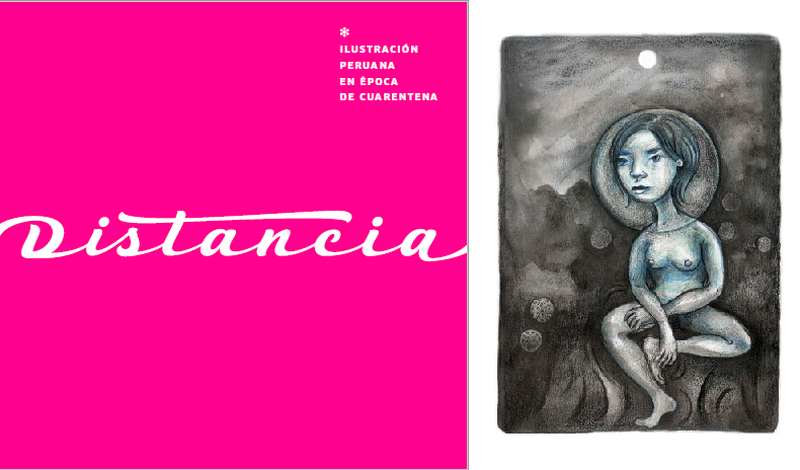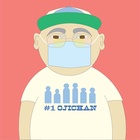At first, the first social reaction promoted by the Peruvian government due to the health emergency caused by the covid-19 virus was to comply with a strict quarantine to avoid contagion that has become a catastrophic pandemic. It seemed peculiar to many to see the empty streets, but soon this isolation unleashed different manifestations (creativity, solidarity and also chaos and health, economic and educational crises), which have become noticeable during all these weeks.
The quarantine has caused lethal effects, but also a social response that, in the case of illustrators, has sought to offer a collective contribution from their specialty. They are part of the Peruvian illustration community, among whom are the young Nikkei people Celeste Vargas Hoshi, Ana Sofía Villanueva Imafuku and Víctor Ynami, who participated in the “ Distancia ” project, Peruvian illustration in times of quarantine under the coordination of the manager cultural and illustrator Kike Mendoza, expresses what these creators are feeling during isolation due to the coronavirus.
More than fifty Peruvian illustrators, some with great experience who have even exhibited outside the country, have participated in this project that has been available since April 23 and is the response of these creators to the new reality that keeps us distanced. The original idea is by Gabriel Alayza, the layout and design is the work of Lucho Chumpitazi and the cover lettering by Elliot Tupac, who offered their talent for this noble initiative. The purpose was to highlight multiple themes, such as awareness, the daily life of confinement, empathy with nature, distancing from the community and friends, and a new reality through a poetic, children's, social, educational and even vision. humorous.
Here we continue
The document is an artistic manifesto in which we reflect on “the futility of existence”, on the planet and nature. “The idea was to have a multiplicity of themes and styles,” said Kike Mendoza in an interview ; raise awareness about what is happening in the world and the reality we are living. Death, loneliness, sadness and terror expressed through graphics that refer to social networks (David Ávalos), interrupted education (Iván Ciro Palomino), or isolation (María Paula Núñez), among other topics.
The drawing of the coronavirus virion stands out in many works as the symbol of terror (José Jáuregui, Kelly Agrada, Jean Kolbert Izquierdo, Avril Filomeno), while others have used art to give a message that highlights caution (Gabriel Alayza , Jorge Lévano, Daniela Zamalloa) or the refuge in reading (Pamela Monzón, Natalí Sejuro, Mauri Apaza, Lucía Quispe). Three Nikkei artists tell their experience in this quarantine and what it meant for them to participate in this unique project with different perspectives that seeks to awaken empathy and self-awareness in each one.
Against anxiety
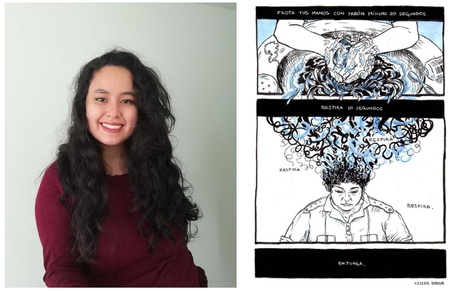
Celeste Vargas Hoshi studied at the Faculty of Art and Design of the Pontifical Catholic University of Peru and specialized in engraving, but works as an illustrator. He has made the cover of the book “Once upon a time there was a Peruvian woman” (Xilófono, 2019), as well as other drawings for books, children's stories and other publications. “If you ask me what I wanted in life… I just wanted to draw. For me, illustration is like a dialogue with whoever interacts with it,” says Celeste.
When she was summoned by Kike Mendoza, she thought about the collective stress and uncertainty, “knowing that compatriots are dying and the only way to help each other is to stay at home and do nothing… it gives us a new form of anxiety that we cannot resist.” “We had seen each other before.” From there came the name of his ink and watercolor drawing “Instructions for washing your hands during quarantine anxiety,” which contains a very useful message for these times: “rub your hands with soap for at least 20 seconds. Breathe for 10 seconds. Rinse.”
“'Quarantine depression' is a real situation. I think about friends who are already neurodivergent like me: depression, clinical anxiety, borderline. Going to your doctor or your psychologist is no longer a simple option, but at the same time it is an important issue. I wanted to adapt the recommendations of the Ministry of Health to what is also necessary: mental health. Focus, breathe and continue. Suddenly we have a lot of free time and at the same time we feel that it slips through our hands in the blink of an eye,” he says.
The call of art
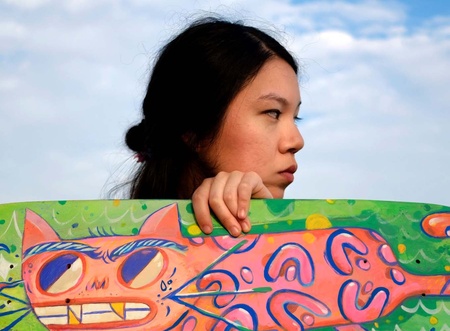
Ana Sofía Villanueva Imafuku has always liked to paint. For this artist, creative work is a reason to discover things, whether on a plastic level (playing with the textures of materials or contrasting colors) or on a personal level, by seeing how images and themes from her subconscious come together. “I seek to create expressive images that open the way to personal connections,” says the artist who has designed advertisements, painted murals and illustrated books.
For this Nikkei designer, the quarantine has generated the need for unity and community in cultural activity, a positive effect in the face of the cancellation of various activities and the crisis in the sector. "I think that this period of emergency has been a wake-up call for the gaps that exist in the cultural sector and a call to action, to the formation of community in the different areas of art."
In “Distancia”, Ana Sofía participated with a mixed media drawing that shows an experience of isolation and vulnerability. “It reflects my perception during the first month of quarantine, where the idea of the outside being so uncertain warranted the search for a personal space of calm for reflection and contemplation of oneself.” In your case, the sudden pause in personal projects and the family business has affected your life and that of your loved ones. “However, I am quite grateful because we are all in good health and I think that at this moment that is the most important thing.”
Dreaming of the happy ending

Víctor Ynami entered the Faculty of Art of the Pontifical Catholic University in 2009. He studied graphic design, but he was always more interested in illustration, which led him to get involved in the publishing world, where he discovered the illustration of children's and youth literature ( He illustrated the book “Papadipatata”, written by Diana Solórzano, as well as drawings about children's stories by the Brothers Grimm). He has also designed for performing arts. “For me it is essential to constantly explore techniques, forms, styles to feed the discourse that each image may have.”
“Distancia” allowed him to connect with other Peruvian designers, “an opportunity to do something together.” With regret, Víctor points out that this situation has affected culture (in his case, he has confirmed this due to the issue of illustrated books), so it seems difficult for this sector to recover soon. He has continued his work as a teacher through the virtual modality and has had the opportunity to strengthen his relationship with his family. “We must be grateful for all those things that went unnoticed in our regular and chaotic world,” says Víctor.
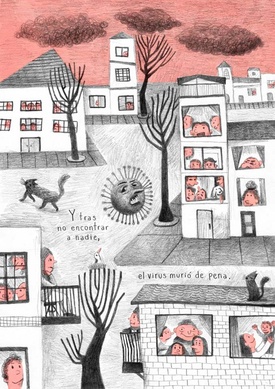
Anxiety and fear of going out have been part of Víctor's visual proposal, which is linked to children's literature. In fact, it is the illustration that closes the book because it seems like the happy ending that we all hope for this pandemic. “And after not finding anyone, the virus died of grief,” he writes in his illustration. “My proposal has always been very close to the illustrated album format and its text-image parameters,” adds Ynami. "I don't know if art is the most effective way, but it has served many to communicate both a light of hope and also to say 'hey, I'm afraid too.' It is human to feel afraid.”
Union and solidarity
Raising awareness, facing this crisis with responsibility and solidarity are part of the messages that emerge from the reflections of these young Nikkei artists. For Celeste Vargas Hoshi, art has been one of the many areas affected, with large events that have been canceled, such as the Lima International Book Fair. “I think it is time to look for new alternatives, take advantage of the time to spread on the networks.” On the one hand, it is aware of the inequality in this crisis, but it rescues collections and donations, in addition to the sacrifice of many for their families. “There are many initiatives to restore our spirits.”
Ana Sofía Villanueva Imafuku emphasizes the importance of ensuring the maintenance and development of public institutions and systems at all levels. “The pandemic has made us see that common well-being is necessary for personal development.” He believes that, although for the Nikkei the idea of the collective is internalized, “it is a good time to put it into practice and get involved in the various areas that community life implies, from the field in which we work or from our capabilities.” .
Víctor Ynami points out that we are not on vacation, these are hard times and unity is the best way to face this serious global situation. “From there onwards,” he says with the enthusiasm that his illustration conveys. In this regard, he adds that there are other initiatives that are taking place as a result of Covid-19, such as the contest by the clothing brand M.bo to create a new line of polo shirts based on illustrations that highlight a positive aspect of this pandemic, and where the work of another Nikkei artist, Diego Uehara, was chosen. With an initiative like “Distancia”, Peruvian artists are more united than ever.
© 2020 Javier García Wong-Kit


